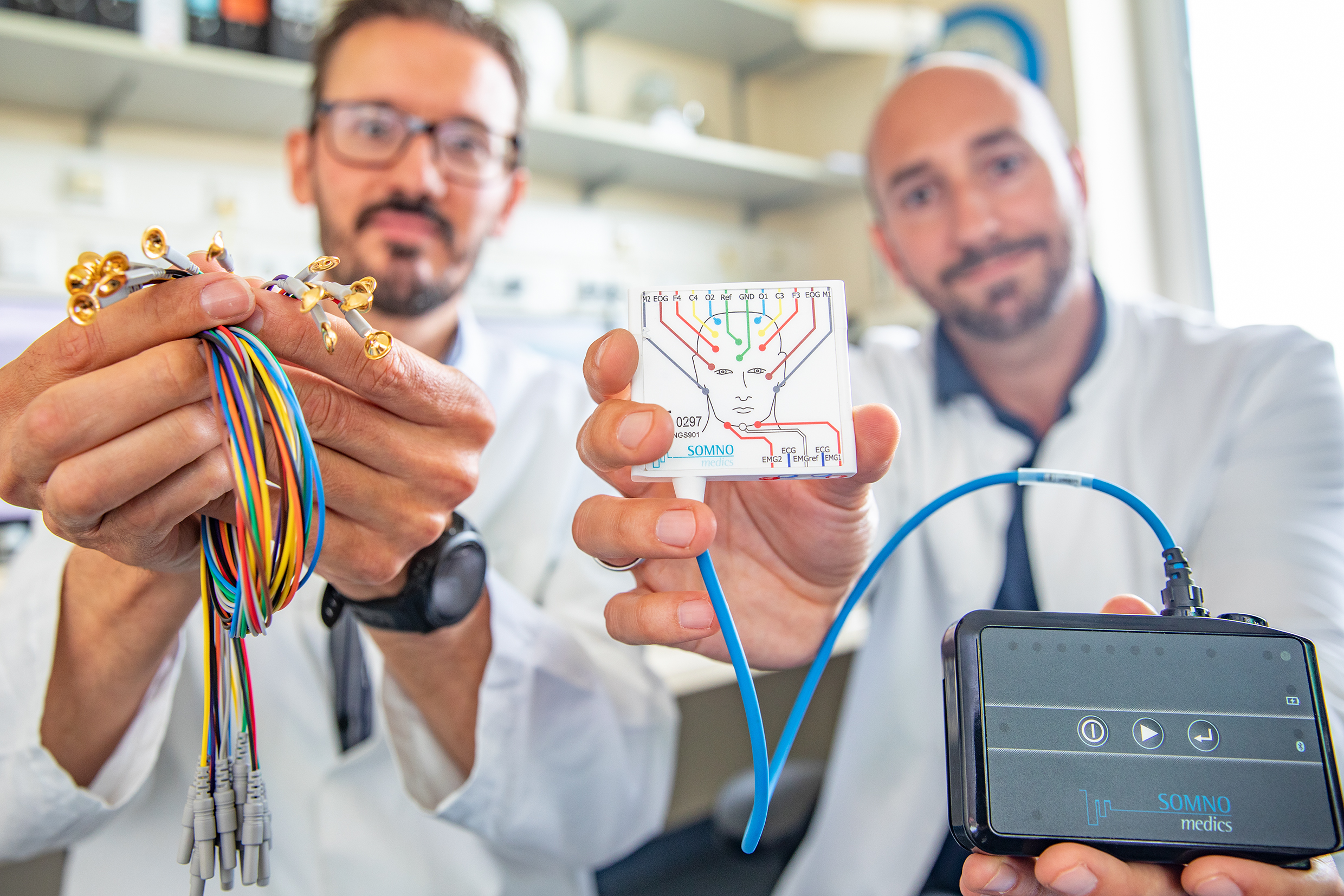Disturbed dream sleep may indicate later Parkinson's disease.

Wanting to detect sleep disturbances in Parkinson's patients and track the early phase of the disease: MHH neurologists Dr. Matthias Höllerhage (left) and Dr. Martin Klietz with the mobile device for video polysomnography. Copyright: Karin Kaiser / MHH.
Parkinson's disease is the second most common neurodegenerative disease and affects more than 400,000 people in Germany, according to current estimates. The cause is a misfolded protein called alpha-synuclein, which clumps together and is deposited in the brain. This causes nerve cells to die. The typical symptoms, such as slowed movements, muscle stiffness or tremors, usually only appear many years later, when the brain has already been irrevocably damaged. However, there are also reliable precursors that indicate an impending Parkinson's disease long before it becomes noticeable through motor deficits. These include a typical behavioral disturbance in the REM sleep phase, in which most dreams also take place. Researchers at the Department of Neurology with Clinical Neurophysiology at Hannover Medical School (MHH) now want to establish a study cohort of people affected by REM sleep behavior disorder to better investigate the preliminary phase of Parkinson's disease and find new biomarkers for early diagnosis and therapy.
Sleep disturbance as a sure sign of Parkinson's risk
The REM sleep phase is characterized, among other things, by rapid eye movement (REM) with closed eyelids. In healthy people, the skeletal muscles are relaxed during this phase. People with REM sleep behavior disorder (RBD), on the other hand, show muscle activity ranging from mild twitching to brisk movements of the whole body, often combined with crying or speech utterances. "If there are no other causes, such as drug use or taking certain medications, 80 to 90 percent of those affected will develop Parkinson's or a Parkinson's-like disease within the next ten years," says senior physician Dr. Martin Klietz. This makes the disorder currently the surest clinical sign of an existing Parkinson's risk - and a good approach for successful treatment.
Diagnosis using mobile sleep monitoring
"At this early stage, not so many nerve cells have been destroyed," the neurologist explains. "So far, therapies only kick in when patients show motor abnormalities. But by then, at least half of the nerve cells in the brain have already perished. "Clinical trials with patients at this stage have therefore been unsuccessful, he said. Together with his colleague, senior physician Dr. Matthias Höllerhage, the physician now wants to take a different approach and identify those affected in the preliminary phase. To do this, the neurologists invite patients with possible REM sleep behavior disorder to a telephone interview and first record their data and medical history. In the next step, they check whether the individual case is actually RBD. This is done by means of sleep monitoring via video polysomnography. During sleep, brain waves and muscle tension are recorded via electrodes, and the oxygen content of the blood and air flow are also measured. Image and sound recordings also document whether patients snore, speak or move. Because the measuring device is mobile, the participants do not have to spend the night in the clinic for sleep monitoring.
Saving nerve cells from destruction
If the signs point to RBD, further investigations should support the suspicion of a Parkinson's preliminary phase. This is done by MRI imaging of the head and by examining the nerve fluid for deposits of the misfolded protein alpha-synuclein. In addition to learning about their health condition, the subjects benefit directly from the clinic's expertise. "We are the only center for Parkinson's disease in the region with a proven focus on caring for patients at all stages of the disease, and we will continue to follow the participants," the neurologist emphasizes. As part of the study, the researchers plan to screen blood samples for potential biomarkers and collect the data and biomaterial in a biobank. "We would like to get to the point with our research where we know how to save the nerve cells," Dr. Höllerhage notes. In the long term, the neurologists then want to test therapy options in clinical trials to treat patients in the Parkinson's preliminary phase neuroprotectively and save the nerve cells in the brain from perishing. "The goal is that Parkinson's can be stopped in the future before the brain suffers massive damage," explains Dr. Klietz.
Participants wanted
For more information about the study, interested parties can contact RBD@mh-hannover.de.
Author: Kirsten Pötzke